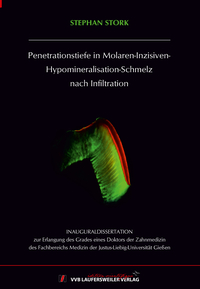
The Molar-Incisor-Hypomineralisation (MIH) is a disease of increasing interest to den-tists. According to Lopes et al., the prevalence is about 13.5% worldwide in 2021. The enamel of permanent first molars and incisors shows porous, white-creamy to yellow-brownish discolouration right after eruption, which tends to break down and can be pain-ful. Due to unclear aetiology, current therapy concepts mainly recommend invasive restorations. A prospecitve alternative to this is resin infiltration as an established meth-od for stabilising initial carious lesions. The aim of this study was to develop a method for infiltration of MIH enamel by using ICON® (DMG) after the application of different pretreatment protocols. The effect of different pretreatment protocols on the penetration depths of a caries infiltrant into the MIH enamel was to be evaluated. After cleaning and documentation of the lesion colour of all teeth, five initially carious molars and premolars (IC) were examined as a control group. Twenty-five MIH-molars (n=5) were randomly assigned to the pretreatment protocols of no pretreatment (MIH + K), bleaching with sodium hypochlorite solution (MIH + N), microabrasion (MIH + M), air abrasion (MIH + A) and air abrasion followed by bleaching with sodium hypochlorite solution (MIH + A + N). After the pretreatment, all teeth were subjected to the indirect fluorescence staining method according to Paris et al. The depths of lesion and penetration were determined at five sites and percentage penetration was calculat-ed using images of the tooth halves taken with a confocal laser scanning microscope (CLSM, Nikon C1, Tokiyo, Japan). In addition, exemplary acquisitions were carried out using the DM6-SP8 DIVE multiphoton microscope (MPM, Leica Microsystems GmbH, Wetzlar, Germany) and the scanning electron microscope (SEM). A mixed linear model was chosen to estimate the influence of tooth variability and the effect of pretreatment on penetration depths. The residuals were estimated using re-stricted maximum likelihood (REML). Analyses of variance were performed within the estimates. In summary, the absolute penetration depths of IC and MIH are comparable, however, MIH is insufficiently infiltrated. Thus, infiltration of MIH cannot be recommended. Aes-thetic improvement of the discolouration, as in the treatment of initial caries, is not to be expected. Further in vitro studies should follow, investigating the aim of complete infil-tration as well as the changes in mechanical properties of MIH-enamel.